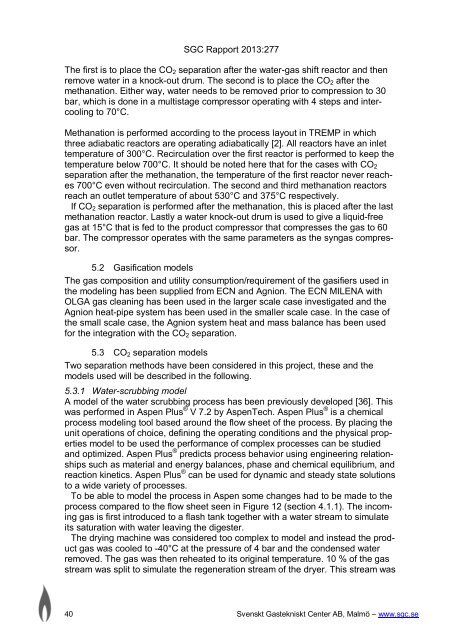Carbon dioxide removal in indirect gasification - SGC
Carbon dioxide removal in indirect gasification - SGC
Carbon dioxide removal in indirect gasification - SGC
Create successful ePaper yourself
Turn your PDF publications into a flip-book with our unique Google optimized e-Paper software.
<strong>SGC</strong> Rapport 2013:277<br />
The first is to place the CO2 separation after the water-gas shift reactor and then<br />
remove water <strong>in</strong> a knock-out drum. The second is to place the CO2 after the<br />
methanation. Either way, water needs to be removed prior to compression to 30<br />
bar, which is done <strong>in</strong> a multistage compressor operat<strong>in</strong>g with 4 steps and <strong>in</strong>tercool<strong>in</strong>g<br />
to 70°C.<br />
Methanation is performed accord<strong>in</strong>g to the process layout <strong>in</strong> TREMP <strong>in</strong> which<br />
three adiabatic reactors are operat<strong>in</strong>g adiabatically [2]. All reactors have an <strong>in</strong>let<br />
temperature of 300°C. Recirculation over the first reactor is performed to keep the<br />
temperature below 700°C. It should be noted here that for the cases with CO2<br />
separation after the methanation, the temperature of the first reactor never reaches<br />
700°C even without recirculation. The second and third methanation reactors<br />
reach an outlet temperature of about 530°C and 375°C respectively.<br />
If CO2 separation is performed after the methanation, this is placed after the last<br />
methanation reactor. Lastly a water knock-out drum is used to give a liquid-free<br />
gas at 15°C that is fed to the product compressor that compresses the gas to 60<br />
bar. The compressor operates with the same parameters as the syngas compressor.<br />
5.2 Gasification models<br />
The gas composition and utility consumption/requirement of the gasifiers used <strong>in</strong><br />
the model<strong>in</strong>g has been supplied from ECN and Agnion. The ECN MILENA with<br />
OLGA gas clean<strong>in</strong>g has been used <strong>in</strong> the larger scale case <strong>in</strong>vestigated and the<br />
Agnion heat-pipe system has been used <strong>in</strong> the smaller scale case. In the case of<br />
the small scale case, the Agnion system heat and mass balance has been used<br />
for the <strong>in</strong>tegration with the CO2 separation.<br />
5.3 CO2 separation models<br />
Two separation methods have been considered <strong>in</strong> this project, these and the<br />
models used will be described <strong>in</strong> the follow<strong>in</strong>g.<br />
5.3.1 Water-scrubb<strong>in</strong>g model<br />
A model of the water scrubb<strong>in</strong>g process has been previously developed [36]. This<br />
was performed <strong>in</strong> Aspen Plus ® V 7.2 by AspenTech. Aspen Plus ® is a chemical<br />
process model<strong>in</strong>g tool based around the flow sheet of the process. By plac<strong>in</strong>g the<br />
unit operations of choice, def<strong>in</strong><strong>in</strong>g the operat<strong>in</strong>g conditions and the physical properties<br />
model to be used the performance of complex processes can be studied<br />
and optimized. Aspen Plus ® predicts process behavior us<strong>in</strong>g eng<strong>in</strong>eer<strong>in</strong>g relationships<br />
such as material and energy balances, phase and chemical equilibrium, and<br />
reaction k<strong>in</strong>etics. Aspen Plus ® can be used for dynamic and steady state solutions<br />
to a wide variety of processes.<br />
To be able to model the process <strong>in</strong> Aspen some changes had to be made to the<br />
process compared to the flow sheet seen <strong>in</strong> Figure 12 (section 4.1.1). The <strong>in</strong>com<strong>in</strong>g<br />
gas is first <strong>in</strong>troduced to a flash tank together with a water stream to simulate<br />
its saturation with water leav<strong>in</strong>g the digester.<br />
The dry<strong>in</strong>g mach<strong>in</strong>e was considered too complex to model and <strong>in</strong>stead the product<br />
gas was cooled to -40°C at the pressure of 4 bar and the condensed water<br />
removed. The gas was then reheated to its orig<strong>in</strong>al temperature. 10 % of the gas<br />
stream was split to simulate the regeneration stream of the dryer. This stream was<br />
40 Svenskt Gastekniskt Center AB, Malmö – www.sgc.se

















